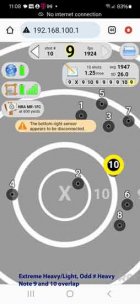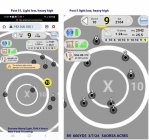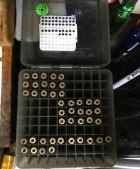Building a table in this post, check back later. Need more coffee.
Separated the medium 10 plus 4 sighters from the Heavy/Light test.
1 -- 3.765, 3.400, 0.365, 3036.8
30 - 3.625, 3.375, 0.250, 2989.2
2 -- 3.760, 3.390, 0.370, 3042.7
29 - 3.625, 3.360, 0.265, 2989.0
3 -- 3.765, 3.385, 0.380, 3054.4
28 - 3.620, 3.360, 0.260, 2987.4
4 -- 3.775, 3.405, 0.370, 3058.4
27 - 3.615, 3.370, 0.245, 2993.1
5 -- 3.755, 3.395, 0.360, 3050.2
26 - 3.610, 3.360, 0.250, 2977.4
6 -- 3.755, 3.395, 0.360, 3046.2
25 - 3.630, 3.380, 0.250, 2996.3
7 -- 3.750, 3.395, 0.355, 3037.8
24 - 3.630, 3.370, 0.260, 2982.8
8 -- 3.750, 3.385, 0.365, 3047.0
23 - 3.630, 3.370, 0.260, 2992.5
9 -- 3.750, 3.390, 0.360, 3055.4
22 - 3.635, 3.370, 0.265, 2987.9
10 -- 3.750, 3.390, 0.360, 3029.2
21 - 3.635, 3.365, 0.270, 3021.1
11 -- 3.740, 3.380, 0.360, 3055.1
20 - 3.635, 3.360, 0.275, 3010.1
12 -- 3.730, 3.385, 0.345, 3053.5
19 - 3.630, 3.360, 0.270, 3010.3
13 -- 3.730, 3.380, 0.350, 3063.0
18 - 3.635, 3.360, 0.275, 3013.2
14 -- 3.730, 3.380, 0.350, 3032.3
17 - 3.635, 3.370, 0.265, 3003.1
15 -- 3.730, 3.385, 0.345, 3044.6
16 - 3.640, 3.375, 0.265 2999.9
Range of primers: 0.165 grains
Range as fired: 0.045 grains
Range of weight loss: 0.135 grains
Extreme Spread of Garmin Xero muzzle velocities 85.6 fps.
Medium 10 +4
Initial weight 3.66 +/- 0.02 grains.
As fired weight 3.390 - 3.365grains.
Weight loss 0.270 - 0.295 grains.
Weight loss with initial sort tolerance (3.66 bin) of +/- 0.02grains, 0.250 - 0.315grains.

















